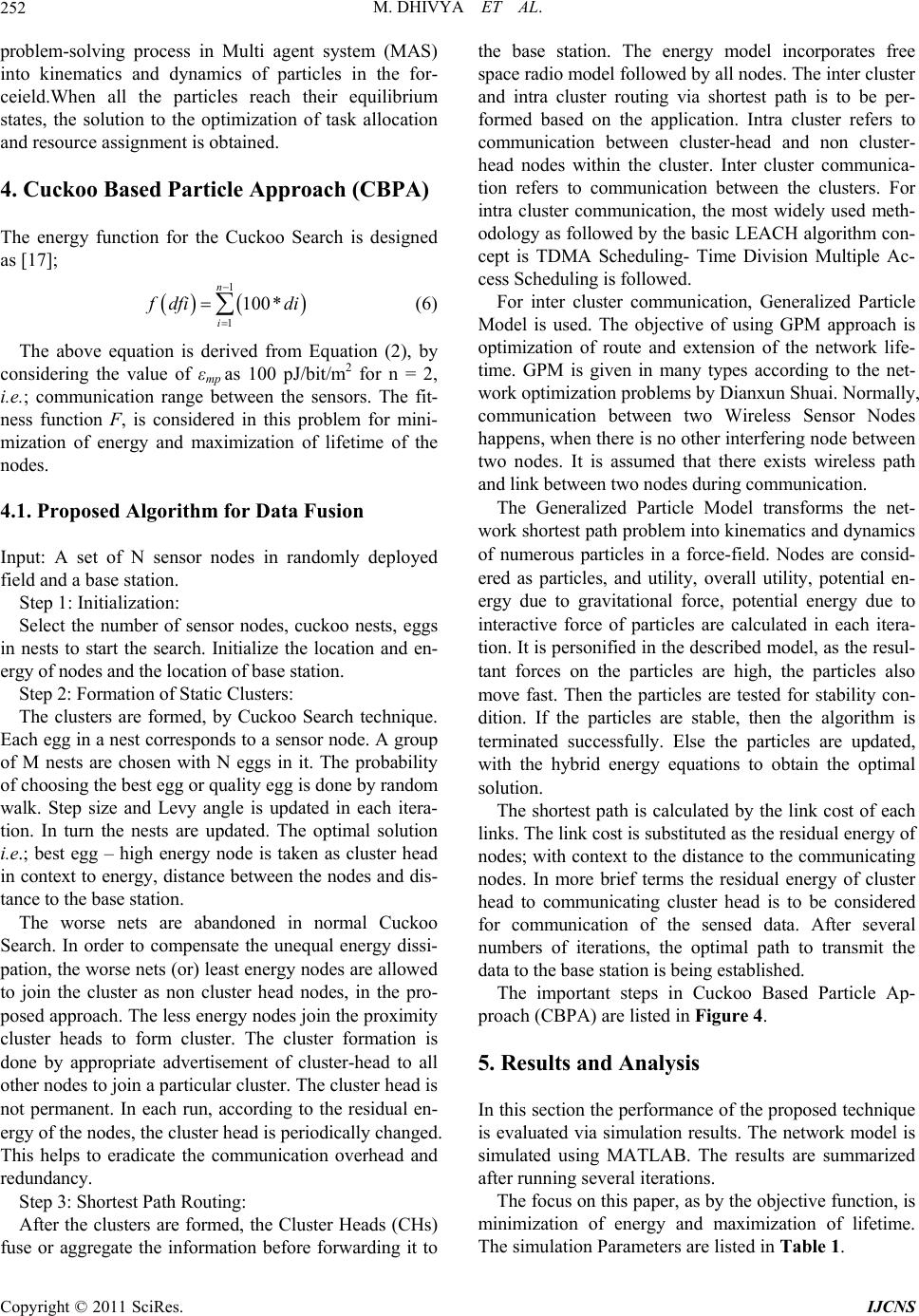
M. DHIVYA ET AL.
252
problem-solving process in Multi agent system (MAS)
into kinematics and dynamics of particles in the for-
ceield.When all the particles reach their equilibrium
states, the solution to the optimization of task allocation
and resource assignment is obtained.
4. Cuckoo Based Particle Approach (CBPA)
The energy function for the Cuckoo Search is designed
as [17];
1
1
100*
n
i
dfi di
(6)
The above equation is derived from Equation (2), by
considering the value of εmp as 100 pJ/bit/m2 for n = 2,
i.e.; communication range between the sensors. The fit-
ness function F, is considered in this problem for mini-
mization of energy and maximization of lifetime of the
nodes.
4.1. Proposed Algorithm for Data Fusion
Input: A set of N sensor nodes in randomly deployed
field and a base station.
Step 1: Initialization:
Select the number of sensor nodes, cuckoo nests, eggs
in nests to start the search. Initialize the location and en-
ergy of nodes and the location of base station.
Step 2: Formation of Static Clusters:
The clusters are formed, by Cuckoo Search technique.
Each egg in a nest corresponds to a sensor node. A group
of M nests are chosen with N eggs in it. The probability
of choosing the best egg or quality egg is done by random
walk. Step size and Levy angle is updated in each itera-
tion. In turn the nests are updated. The optimal solution
i.e.; best egg – high energy node is taken as cluster head
in context to energy, distance between the nodes and dis-
tance to the base station.
The worse nets are abandoned in normal Cuckoo
Search. In order to compensate the unequal energy dissi-
pation, the worse nets (or) least energy nodes are allowed
to join the cluster as non cluster head nodes, in the pro-
posed approach. The less energy nodes join the proximity
cluster heads to form cluster. The cluster formation is
done by appropriate advertisement of cluster-head to all
other nodes to join a particular cluster. The cluster head is
not permanent. In each run, according to the residual en-
ergy of the nodes, the cluster head is periodically changed.
This helps to eradicate the communication overhead and
redundancy.
Step 3: Shortest Path Routing:
After the clusters are formed, the Cluster Heads (CHs)
fuse or aggregate the information before forwarding it to
the base station. The energy model incorporates free
space radio model followed by all nodes. The inter cluster
and intra cluster routing via shortest path is to be per-
formed based on the application. Intra cluster refers to
communication between cluster-head and non cluster-
head nodes within the cluster. Inter cluster communica-
tion refers to communication between the clusters. For
intra cluster communication, the most widely used meth-
odology as followed by the basic LEACH algorithm con-
cept is TDMA Scheduling- Time Division Multiple Ac-
cess Scheduling is followed.
For inter cluster communication, Generalized Particle
Model is used. The objective of using GPM approach is
optimization of route and extension of the network life-
time. GPM is given in many types according to the net-
work optimization problems by Dianxun Shuai. Normally,
communication between two Wireless Sensor Nodes
happens, when there is no other interfering node between
two nodes. It is assumed that there exists wireless path
and link between two nodes during communication.
The Generalized Particle Model transforms the net-
work shortest path problem into kinematics and dynamics
of numerous particles in a force-field. Nodes are consid-
ered as particles, and utility, overall utility, potential en-
ergy due to gravitational force, potential energy due to
interactive force of particles are calculated in each itera-
tion. It is personified in the described model, as the resul-
tant forces on the particles are high, the particles also
move fast. Then the particles are tested for stability con-
dition. If the particles are stable, then the algorithm is
terminated successfully. Else the particles are updated,
with the hybrid energy equations to obtain the optimal
solution.
The shortest path is calculated by the link cost of each
links. The link cost is substituted as the residual energy of
nodes; with context to the distance to the communicating
nodes. In more brief terms the residual energy of cluster
head to communicating cluster head is to be considered
for communication of the sensed data. After several
numbers of iterations, the optimal path to transmit the
data to the base station is being established.
The important steps in Cuckoo Based Particle Ap-
proach (CBPA) are listed in Figure 4.
5. Results and Analysis
In this section the performance of the proposed technique
is evaluated via simulation results. The network model is
simulated using MATLAB. The results are summarized
after running several iterations.
The focus on this paper, as by the objective function, is
minimization of energy and maximization of lifetime.
The simulation Parameters are listed in Table 1.
Copyright © 2011 SciRes. IJCNS